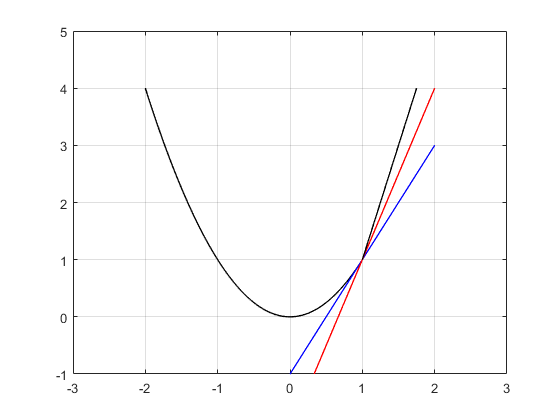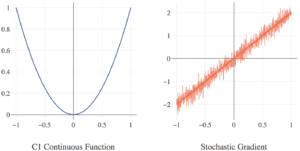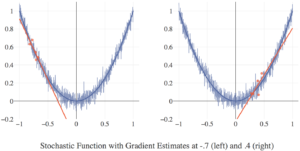Subgradient Method
Subgradient method is the basic optimization algorithm for convex nondifferentiable functions. First, let’s see what a subgradient is. A subgradient is a generalization of the gradient for nondifferentiable functions. For simplicity, let’s elaborate it in a one-dimensional space. The gradient of a function at a certain point is the slope of the tangent line at that point.

However, for nondifferentiable functions, there is no unique gradient at nondifferentiable points. Instead, there are subgradients which satisfy the following condition:
for all y.
All vectors that satisfy this condition are called subgradients of the function J at point x.

In Fig. 2, you can see that slopes of both blue and red lines are subgradients of the function at .
Now assume that our goal is to minimize the cost function . The update algorithm is simply
where is subgradient of
at point
.
However, the subgradient direction is not always a descent direction (can you think of an example?), so we have to keep track of the smallest objective function value that we have reached so far(i.e. iteration ):
The proof of convergence for this algorithm depends on three conditions:
- The function
is a convex function. However, it is not necessarily strongly convex.
- The size of the subgradient is bounded, i.e,
for all
. For example, if the function
is Lipschitz continuous, then its subgradient is bounded.
- The distance of the initial point to the optimal set is bounded by
, i.e.,
.
With the aforementioned conditions, it is shown that the distance between best point found so far of the algorithm with the optimum value
is bounded, i.e.,
Now, depending on the step size , we find different values for the bound. Two step sizes that we went through their detail in the class were:
- Constant step size
: which is a positive constant. In this case, we will have
. As
goes to infinity, the bound converges to
.
- Square summable but not summable
,
We showed that the convergence rate in both cases are sublinear with the definition here.
Also, we discussed in class that if the number of iterations is determined, i.e., we want to reach the best we can in iterations, then the best possible bound that we can get with any step size is:
Using this bound, we found that if we want to reduce the gap between the current objective value and the optimal objective by a factor of 1000, we need iterations. To compare it with the gradient descent method, we have to note that if
, then it only needs 10 iterations in gradient descent. However, this gradient descent convergence rate is for strongly convex case only.
Stochastic Gradient Descent
We have seen that we can use standard gradient descent given a convex function and its gradient. We discussed earlier in this section that we can use subgradient descent given a convex function with undefined gradient and its subgradient. What approach is appropriate when we are given a convex function with a stochastic gradient?

Stochastic gradient descent (SGD) is a term used to describe the application of classic gradient descent and subgradient methods when only a stochastic estimate of the true (sub)gradient is available.
To get a better feel for what this means and why this is useful, imagine the following two motivating examples. First, consider the training of a neural network (NN) when we have millions of training samples. The huge number of training samples causes the calculation of the gradient to be very expensive, making training slow. We could randomly select a subset of training samples (say, 1000 of them) and compute a gradient with respect to only that sample. We assume (and in this case, know) that the gradient estimate generated from a sample will behave like the true gradient on average and still point us in a general descent direction.
In another example consider a black box optimization problem, meaning that the optimization algorithm only has access to actual function values *without* gradient information. At first glance, it may seem like gradient descent methods cannot be used for this problem. However, if we assume that the underlying function has some amount of “smoothness” and randomly sample function values near the current iterate, we can use a least squares fit to estimate the gradient.

In general, the formal assumption for any SGD method is that the optimization algorithm has access to an estimate for the true (sub)gradient
at every point
, which satisfies
where denotes the expected value of
at
.
Using as a proxy for
, we can perform standard (sub)gradient descent in order to converge in expected value to the true minimum. That is, we can use the “vanilla” SGD update
where is the step size.
We see two convergence proofs for this vanilla SGD. The first leverages an inductive argument to show that for a strongly convex differentiable function $f$, after iterations using a diminishing step size
, the expected error in function value is given by
where is the true optimal value for
.
In a slight modification, often called “robust” SGD, we relax the assumptions so that need only be convex with a subgradient. Now, using a constant step size
, robust SGD can be proven to converge to some neighborhood of the true minima
with a radius proportional to
at a rate of
. It follows, that for a general function, it is good practice to begin SGD with a constant step size, then diminish the step size whenever the algorithm seems to have stalled in its progress.